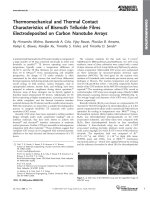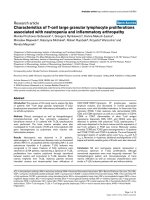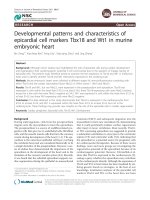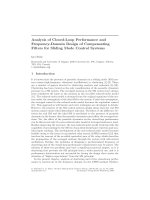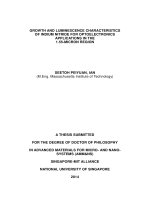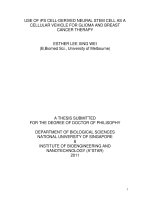Characteristics of closed cell aluminum foams
Bạn đang xem bản rút gọn của tài liệu. Xem và tải ngay bản đầy đủ của tài liệu tại đây (2.8 MB, 41 trang )
Characteristics of Closed Cell
Aluminum Foams
Efficient energy absorption
Excellent stiffness-to-weight ratio
Nearly isotropic - Multiaxial loading
Low thermal conductivity
Fire resistant
Shock wave attenuation
Sound and vibration damping and absorption
Tailorable density and properties
Recyclable
Production Process for
Aluminum Foam Parts
Mixing
Press
Extrusion
press
F
Al - Powder
(Alloys)
+TiH2 - Powder
CIP
Foamable
precursor
Mold
Heating
Foaming
T ~ 700 °C
Aluminum foam
3-D-part
Al Foams: Flat plates and 3-D shapes for
cores in lightweight aluminum castings
Quasi-Static Behavior of Aluminum Foam
60
ρ0
ρ0
ρ0
ρ0
Engineering Stress, MPa.
50
=
=
=
=
0 .8 2
0 .5 7
0 .4 7
0 .3 4
gm
gm
gm
gm
/c c
/c c
/c c
/c c
40
30
20
10
0
0
0 .1
0 .2
0 .3
0 .4
E n g in e e r in g S t r a in .
0 .5
0 .6
0 .7
Aluminum Foam Filled 304SS Tubes
After Axial Compression
3-D molded foam shape for auto
crash energy absorption
Aluminum foam insert used for stiffening
and energy absorption in auto side rail
Tailorability of Aluminum Foams
50
10
σ [MPa]
1
0.5
3
Density (g/cm )
1.0
Plateau stress of Al-12Si foams as a function of foam density
Tailorability of Aluminum Foams
E [GPa]
50
10
1
0.5
0.1
1.0
Relative density
Elastic modulus of Al-12Si foams as a function of density
Aluminum Foam Used in Hybrid Vehicle Armor
Alumina Ceramic
Aluminum Foam
Fiber reinforced polymer
Cross-section through lightweight armor using aluminum
foam layer, after 20 mm FSP ballistic testing for the U.S. Army.
Aluminum foam impedance layer provides:
• Improved defeat of projectile
• Enhanced ballistic shock wave attenuation
• Lower dynamic deflection of backplate
Aluminum Foam Frame for Ballistic
Stress Wave Management
External Aluminum Foam
Frame Offset Impact
Force measurements for shots 13-16
Without Al Foam vs. With Al Foam
Location 2
Location 3
0
0
-5
-5
3
Force(Kilo-Lb)
Force(Kilo-Lb)
-10
-15
-20
-25
-10
-15
2
-20
No Al foam
No Al foam
With Al foam
With Al foam
-30
-35
0
0.2
0.4
0.6
0.8
Time (ms)
1
1.2
No AL foam
No AL foam
With AL foam
With AL foam
-25
-30
0
0.2
0.4
0.6
0.8
Time (ms)
1
1.2
External Aluminum Foam
Frame - Center Impact
Acceleration Measurements
Without Al Foam vs. With Al Foam
3TEX-4A- 2 W ithout AL foa m
12
12
10
10
Shot 2
6
4
2
0
6
4
2
0
-2
-2
-4
-4
-6
-6
-8
0
2
4
6
Time (ms )
Shot 3
8
Acceleration(Kilo-g)
8
Acceleration(Kilo-g)
3 TEX -4A -3 W ith AL f oam
8
-8
0
2
4
6
Time (ms )
8
Vibration Damping Tests on Al Foam
and Bulk Al Sheets
3 mm
Al sheet
5 mm
Al sheet
25 mm
Al foam
Weight
(kg)
Area
(mm)
1.9
500x500
3.3
500x500
2.0
500x500
Test apparatus for vibration
damping measurements
Impact hammer
with force
sensor
Acceleration sensor
Tested
panel
Frequency Response Curves
After Impact by Hammer
3 mm Al-sheet; Weight:1,9 kg
5 mm Al-Sheet; Weight: 3,3 kg
25 mm Al-Foam panel; Weight: 2 kg
Inertance a/F (ms-2/N)
1600
1400
-2
1200
1000
800
600
400
200
0
0
500
1000
1500
2000
Frequency (Hz)
2500
3000
3500
Damping of vibration after impact by hammer
as measured by surface accelerometer
Acceleration a [ms-2]
300
3 mm Al-sheet; Weight:1,9 kg
200
100
0
-100
0
50
100
150
200
250
200
250
-200
-300
-400
Time (ms)
Acceleration a [ms-2]
300
5 mm Al-Sheet; Weight: 3,3 kg
200
100
0
-100
0
50
100
150
-200
-300
Time (ms)
150
Acceleration a (ms-2)
25 mm Al-Foam panel; Weight: 2 kg
100
50
0
-50
0
50
100
150
-100
-150
Time (ms)
200
250
Damping factor (decay) of 25 mm Al foam
panel vs. 3 mm and 5 mm Al sheets
3 mm Al-sheet; Weight:1,9 kg
5 mm Al-Sheet; Weight: 3,3 kg
25 mm Al-Foam panel; Weight: 2 kg
Decay - Damping factor Eta (-)
1,4E-02
1,2E-02
1,0E-02
8,0E-03
6,0E-03
4,0E-03
2,0E-03
0,0E-03
0
500
1000
1500
Frequency (Hz)
2000
2500
Aluminum Foam Blast Testing
Blast Loading of Aluminum Foam Panels
Test Configuration
Front plate
Al Foam panel
Back plate
(18 in. x 18 in. test area)
1/8 inch thick steel
2 inch thick Al-7Si – 20% density
1/4 inch thick steel
Loading Conditions
Explosive: 1 kg PETN
Standoff distance
Blast Test Results
2 meter
No noticeable damage to foam or steel
0.5 meter
50% deformation of foam
No back plate deflection
0.1 meter
60-80% deformation and fracture of foam
Steel plates deformed but not perforated
Blast test panels after exposure to detonation
of 1 kg PETN at 0.1 m standoff distance
Left:
Center:
Right:
Front steel sheet – 1/8 in. thick
Aluminum foam
Back steel plate - 1/4 in. thick
Compressive plastic deformation and fracture
of aluminum foam exposed to 1 kg PETN explosive
at 0.1 m standoff
Aluminum experienced up to 70-80%
compressive strain in local regions under
1/8 in. thick steel front cover sheet
Aluminum Foam Sandwich Panels
Low-density Al alloy closed cell foam cores
Al foam cores metallurgically bonded to Al
alloy face sheets
Sandwich geometry provides very high
stiffness-to-weight and strength-to-weight
ratios
Available in panel sizes up to 48 x 96 x 0.35
to 4 inch thick
Aluminum Foam Sandwich
panels in various thicknesses
Unfoamed AFS precursor sheets
3100 x 1100 x 2.5 mm

